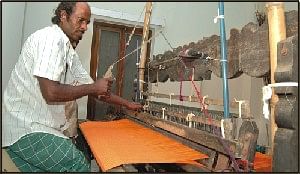Fabric fables
Tale of a weaver
Aftabuddin's 'Purbanchal Check'
Afsar Ahmed
From time immemorial, Bangladesh has earned a reputation as the high quality producer of handloom, especially muslin. Poets of the Mughal Durbar likened our muslins to Baft hawa (woven air), Abe rawan (running water) and Shabnam (morning dew). So fine was its texture and quality that it was said to be woven with the thread of the winds and the Greek and the Roman texts mention the Gangetic muslins as one of the most coveted luxury items. Though those days are now relegated to the past, Bangladesh can still proudly claim to have many branches of this ancient art. The Grameen check is now highly appreciated in the world market. And to revive our acclaimed heritage from the aggression of foreign products, Mohammed Aftabuddin has been working since 1989. Recently Banglar Mela presented him an award for his contribution to the field of weaving. What do we call him? A weaver or an entrepreneur? It was back in late 1980s when Aftab was a branch manager of Grameen Bank at Araihazar, Narayanganj. In this village, 99 per cent of the inhabitants were somehow related to handlooms. As he went about his work, he would hear the songs of the taantis (weavers) and the wonderful sounds created by the looms. But one day he found that the songs and the noises of the looms had disappeared. A curious Aftab wanted to find out more about this phenomenon. He came away with the realisation that the weavers had lost their interest in this ancient art form because of their socio-economic insecurities. Instead of sitting idle, Aftab took the initiatives to help these weavers. And thus the tale of Aftab Check or Purbanchal Check began. At first he started with five looms now the co-operative is an owner of 40 looms. ' Three to four families can survive through one loom,' said Aftab . All the looms used by Aftabuddin are called Chittaranjan Looms. Semi automation is the special feature of those looms. The product which is popularly known as Aftab Check, is made of indigenous materials. It consumes cotton yarn count varying from 2/60s, 2/80s and 40s . Apart from check; checkered , twotones and others are also produced in his looms. 'I always use reactive colours to make elegant designs, unique colour combinations and lasting texture,' said Aftab 'My main aim is to bring about a change in the lifestyle of the weavers. Their lack of proper education hurts me.' He is also willing to work on providing the artisans primary health, proper sanitation and birth control facilities. 'The weavers generally have a big family which is in fact a great obstacle in their economical solvency', he added. The need of the hour, says Aftab, is proper marketing of the weaver's products. 'What we need is reliable sponsors,' pointed out Aftab.
|

A Chittaranjan loom: Reviving a lost craft |